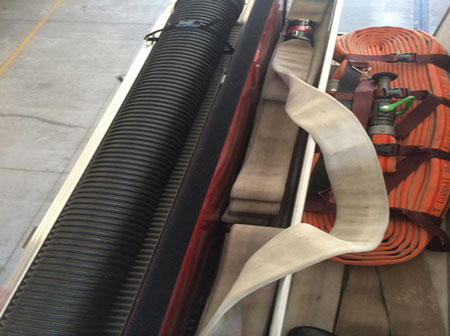 |
| (1) Two DL Blitz Load stacks loaded in the hosebed viewed at the rear of the hosebed. The stack closest to the pump panel is 150 feet of 2½-inch hose, and the stack closest to the rear is 100 feet of 2½-inch hose. The length of the hosebed is divided into two single stacks and coupled on top of the two stacks. (Photos by author.) |
The DL Blitz Load is a 250-foot, 2½-inch blitz attack line equipped with the nozzle of your choice. It is designed for efficiency, maneuverability, and quick deployment for short-staffed or fully staffed volunteer and career engine companies. It offers firefighters a more simple packing procedure and deployment that is considered clean and neat.
 |
| (2) This view shows the bottom loop, which acts as a “tray” for pulling the 100-foot stack from the hosebed and down to the firefighter below for deployment. The loop is not there to put your arm through but rather to bring the stack forward for ease of grabbing it from the rear of the hosebed. |
The lightweight design puts less stress on firefighters before they conduct suppression activities. One firefighter can deploy the load systematically. The DL Blitz Load allows the driver-operator to establish pumping operations while the company officer focuses on the 360° size-up and a single firefighter deploys the blitz load.
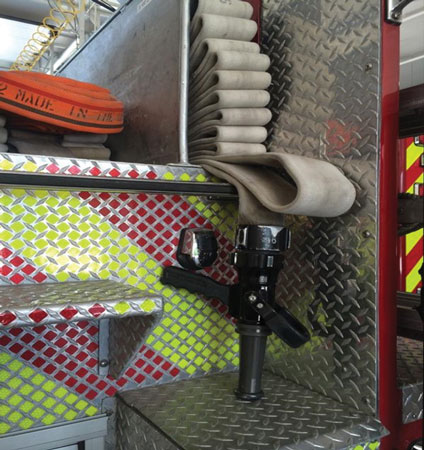 |
| (3) This view shows the DL Blitz Load from the rear of the engine. This 100-foot flat load stack is a single stack that is inverted from the second 150-foot stack. |
The decreased weight of breaking the DL Blitz Load into two stacks allows a firefighter to deploy the load more easily. It can be deployed straight or 45°, 60°, or 90° from the hosebed. The 125-foot pivot point allows the firefighter to change directions when laying the line after the hosebed has been cleared and before the initial 125-foot shoulder stack has been deployed-no more “spaghetti” at the rear of the engine!
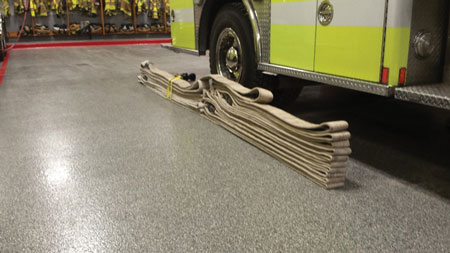 |
| (4) The DL Blitz Load on the apparatus floor, loaded for the length of this engine’s hosebed. |
The DL Blitz Load can be deployed systematically and correctly in under 60 seconds, allowing for decreased firefighter fatigue, a faster fire attack, and a minimal loss of property. This short-staffed engine blitz line deployment also allows crew members to complete other critical tasks during deployment.
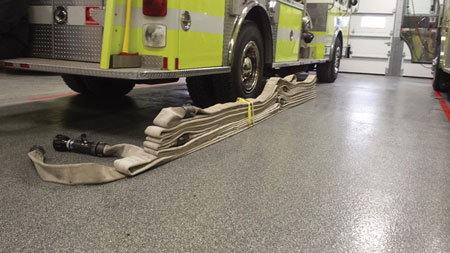 |
| (5) This DL Blitz Load is packed for deployment on the apparatus floor. Note the tail end of the male coupling, which connects to the 2½-inch discharge on the rear of the apparatus and then runs one full length, creating the bottom layer that begins at the rear of the 150-foot flat load. If the 2½-inch discharge was located in your hosebed near the pump panel, the bottom layer of hose would not exist from the rear; it would be the beginning of the 150-foot flat load connected to the discharge by the pump panel. |
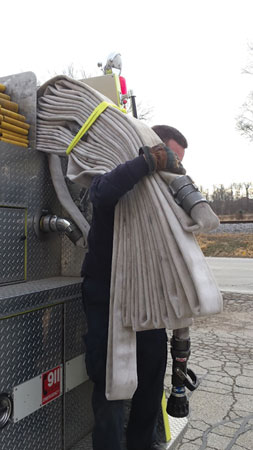 |
| (6) A firefighter deploys the 100-foot flat load section of the DL Blitz Load. The strap is used to hold the load together on the firefighter’s shoulder; it eventually falls off when the load starts to deploy. Although the firefighter is carrying the 100-foot section away from the engine, the second 150-foot section is being deployed, and no mess occurs behind the engine. The load is lightweight, maneuverable, and quickly deployed. |
DUSTIN LOFY is a 13-year fire service veteran and a firefighter/paramedic and in-house instructor with the Franklin (WI) Fire Department. He has a bachelor’s degree in business administration and a master’s degree in business management from Cardinal Stritch University.
The Blitz Attack : Just Blast It!
Drill of the Week: Blitz Attack
Engine Company Operations: Blitz Attack or Rapid Defense?
Fire Engineering Archives

